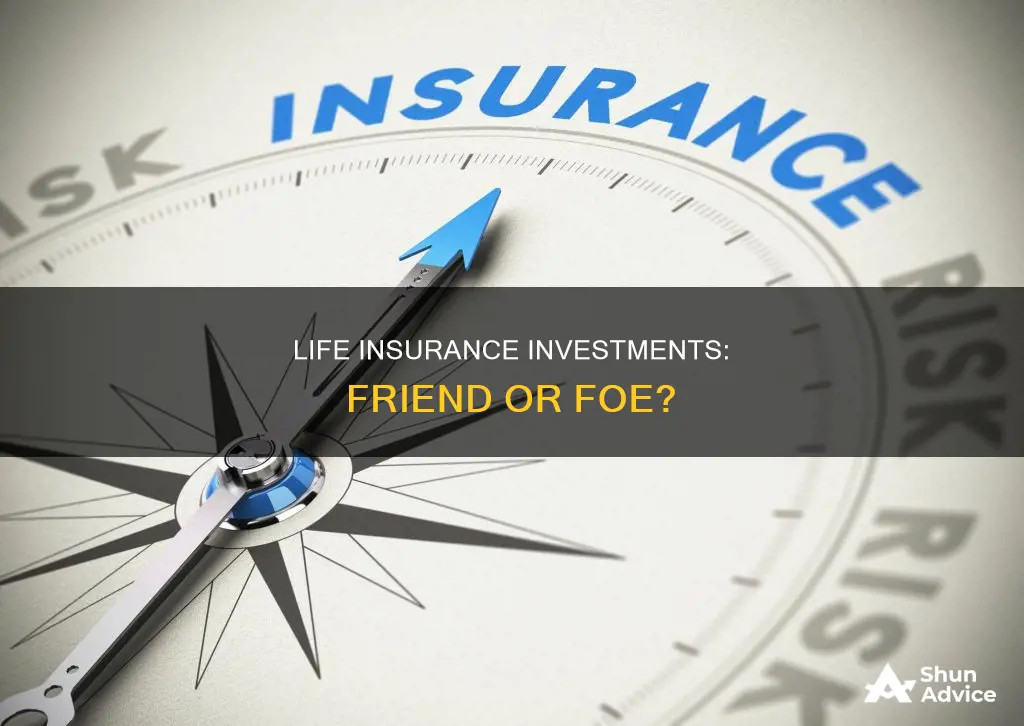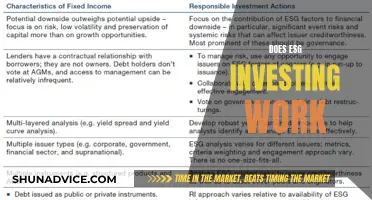
Life insurance is a complex topic, and whether or not it is a good investment depends on several factors, including your financial situation, goals, and risk tolerance.
Life insurance is typically purchased to provide financial security for loved ones in the event of your death. It can also be useful if you have large debts or don't want your family to cover funeral expenses. Term life insurance covers an individual for a set number of years, while permanent life insurance lasts for the remainder of the policyholder's life and may build cash value. This cash value component is where life insurance can be seen as an investment.
Permanent life insurance policies generally carry higher premiums and can be used to provide benefits during retirement or to ensure financial stability for lifelong dependents. However, for most people, there are better ways to invest for retirement, and term life insurance may be a more cost-effective option.
When considering life insurance as an investment, it's important to evaluate your financial situation and goals. If you've maxed out contributions to tax-advantaged accounts, permanent life insurance can provide additional tax-deferred savings. Additionally, the cash value can be accessed through tax-free withdrawals or loans, providing funds for various expenses.
However, the cash value growth rate may be low compared to other investments, and there can be tax implications if you withdraw more than your policy basis. It's also important to note that your beneficiaries do not receive the cash value when you pass away.
In conclusion, while permanent life insurance can provide investment benefits, it may not be the best option for everyone. It is crucial to carefully consider your needs, weigh the pros and cons, and seek expert financial advice before making any decisions.
| Characteristics | Values |
|---|---|
| Purpose | To provide a financial safety net to your beneficiaries after your death |
| Types | Term life insurance, Permanent life insurance |
| Permanent life insurance types | Whole life insurance, Universal life insurance, Variable universal life insurance, Indexed universal life insurance |
| Pros | Permanent coverage, Tax-free withdrawals, Tax-deferred cash value, Access to cash value while alive, Peace of mind |
| Cons | High premiums, Slow cash value growth, Low rate of return, Lack of control over portfolio, Tax implications on withdrawals, Not suitable for everyone |
What You'll Learn

Whole life insurance as an investment
Whole life insurance is a type of permanent life insurance that provides coverage for the duration of the policyholder's life, as long as premiums are paid. It also accumulates a cash value that grows at a fixed rate, which is guaranteed by the insurer. This cash value can be accessed through loans or withdrawals and is useful for paying off debts, covering long-term care, or even funding a vacation.
Whole life insurance may be a good investment option for high-net-worth individuals who have already maxed out their tax-advantaged retirement accounts, such as 401(k) plans or individual retirement accounts. The cash value of whole life insurance grows tax-deferred, providing a source of funding that is available throughout the policyholder's life. Additionally, the death benefit can offer financial protection for family members or other dependents.
However, whole life insurance has some drawbacks. The premiums tend to be much higher than those of term life insurance policies, and the cash value can take a long time to grow, sometimes up to 10 to 15 years. The rate of return on the cash value is also relatively low, typically between 1% and 3.5%. Furthermore, policyholders cannot control their investment portfolio, as the insurance company manages the investments.
Overall, while whole life insurance can be a valuable investment for certain individuals, it may not be suitable for everyone. It is important to carefully consider one's financial situation, goals, and other investment options before deciding to purchase whole life insurance.
Strategic Retirement: Navigating the Best Investment Options for Your $450,000
You may want to see also

Pros and cons of permanent life insurance
Permanent life insurance policies offer lifelong coverage and typically have a cash value component that grows over time. This cash value can be used to pay premiums or take out a loan from the insurer. However, permanent life insurance policies have much higher rates than term policies, making them unsuitable for most people.
Pros of permanent life insurance
- Lifelong coverage: Permanent life insurance policies provide coverage for the entire lifespan of the policyholder, as long as premiums are paid. This means that beneficiaries will receive a death benefit regardless of when the policyholder passes away.
- Cash value component: Most permanent life insurance policies have a cash value component that grows over time, similar to an investment account. Policyholders can withdraw or borrow from this cash value once it reaches a certain amount.
- Tax advantages: The cash value of permanent life insurance policies grows tax-deferred, and there is no income tax on dividends or when surrendering coverage, unless the amount received exceeds the premiums paid. Policy loans are also tax-free as long as the policy remains in effect.
- Flexible premium payments: Some permanent life insurance policies allow policyholders to stop making payments and continue enjoying the benefits of the coverage. For example, policyholders may be able to pay higher premiums for a shorter period and then never have to pay a premium again.
Cons of permanent life insurance
- High cost: Permanent life insurance policies have much higher rates than term policies, making them significantly more expensive than term life insurance. This high cost may not be justifiable for many individuals, especially if their coverage needs change over time.
- Complexity: Permanent life insurance policies are more complex than term policies due to their cash value component and various investment options. This complexity can make it challenging for customers to understand the terms and conditions of their policy fully.
- Possibility of policy lapse: If policyholders miss payments or can no longer afford to make them, their permanent life insurance policy could lapse. This means that they would lose their coverage and may have to purchase a new policy, potentially at a higher premium.
- Mediocre investment returns: Due to the high premiums, permanent life insurance policies may produce mediocre returns on investment. Other investment options may offer higher returns with lower risk.
Uncovering Bargain Land Deals: A Property Investor's Guide
You may want to see also

Term life insurance as an investment
Term life insurance is a type of policy that offers financial protection for a set period, usually 10 to 30 years. It is distinct from permanent life insurance, which covers the insured for their entire life. Term life insurance is often sought by individuals who require coverage during specific periods of their lives, such as parents with young children or those with significant debt.
Term life insurance is an excellent option for many individuals and families, but it does come with certain disadvantages. Here are some of the pros and cons of term life insurance:
Pros of Term Life Insurance
- It is more affordable than permanent life insurance, with premiums that are typically lower due to the absence of a cash value component and the shorter coverage period.
- It offers temporary coverage for temporary financial needs, making it suitable for those who only need insurance for a specific length of time, such as 10, 20, or 30 years.
- It provides predictable costs and stability, especially during key life stages like raising children or paying off debts, with level term life insurance offering constant premiums and death benefits.
- It can be converted to permanent coverage without a medical exam, making it flexible for those who anticipate their long-term needs might change.
- It is a good option for young, newlywed couples as it offers excellent rates for younger and healthier individuals, helping them with financial needs like replacing income or paying off debts.
Cons of Term Life Insurance
- It does not offer lifelong coverage, so it may not be suitable for those who need insurance for their entire lives.
- It does not have a cash value component, so there is no opportunity for investment or borrowing against the policy.
- Renewing the policy after the term ends can result in higher premiums due to age or changes in health.
- It may not be easy to requalify for coverage if health issues arise during the term.
When deciding whether to invest in term life insurance, it is essential to consider your financial goals and needs. Term life insurance can provide peace of mind and financial stability for a set period, making it a good choice for those with temporary financial responsibilities. However, it lacks the investment opportunities and lifelong coverage offered by permanent life insurance.
Food Startups: Invest in Your People
You may want to see also

Permanent life insurance for high-income earners
Permanent life insurance is a type of insurance that covers you for life, as long as you keep up with the premiums. It also has an investment component that allows policyholders to accumulate a cash value. This cash value grows tax-free and can be borrowed against or withdrawn, although any unrepaid funds will lower the death benefit.
Permanent life insurance is generally more expensive than term life insurance, and it may not be the best option for everyone. However, it can be a good choice for high-income earners who are looking for additional tax-efficient investment options and want to ensure they have coverage for life.
Tax Efficiency
Permanent life insurance policies with an investment component allow you to grow wealth on a tax-deferred basis. This means you don't pay taxes on any interest, dividends, or capital gains on the cash value of your policy until you withdraw the proceeds. This can be advantageous for high-income earners who are already maxing out their contributions to tax-advantaged retirement accounts, such as 401(k)s or IRAs, and are looking for additional tax-efficient investment options.
Lifelong Coverage
Unlike term life insurance, which expires at the end of the term, permanent life insurance provides coverage for your entire life as long as you pay the premiums. This can be attractive to high-income earners who want the peace of mind of knowing that they have lifelong coverage, especially if they anticipate having financial dependents beyond the length of a typical term policy.
Investment and Borrowing Opportunities
The cash value component of permanent life insurance provides high-income earners with additional investment opportunities. This can be especially beneficial for those who have reached the contribution caps on their other investment accounts. The cash value can be borrowed against to fund major expenses, such as a child's college tuition, home improvements, or even a dream vacation.
Estate Planning
Permanent life insurance can also play a crucial role in estate planning for high-income earners. The death benefit provided by these policies can help cover estate taxes, ensuring that beneficiaries receive their full inheritance. Additionally, permanent life insurance can provide liquidity to facilitate the distribution of business assets or equalize inheritance among beneficiaries.
Business Protection
For high-income earners who are business owners or co-owners, permanent life insurance can offer protection through buy-sell agreements. These agreements help minimize the financial impact of the death of a business owner or partner by allowing the surviving owner(s) to buy out the deceased's share with the proceeds from the life insurance death benefit.
Charitable Giving
High-income earners can also use permanent life insurance for charitable giving while receiving tax benefits. By naming a charitable organization as the beneficiary of the policy, individuals can make a donation upon their death, and the premiums paid may also be tax-deductible.
Downsides to Consider
While permanent life insurance offers several benefits for high-income earners, there are also some potential downsides to consider. The high cost of premiums is one of the most significant disadvantages. Permanent life insurance tends to be much more expensive than term life insurance, and if it turns out that lifelong coverage is not needed, the high premiums may be unnecessary.
Additionally, permanent life insurance can have complex investment and fee structures, and the cash value may take several years to grow to a significant amount. There may also be tax implications if the policy is surrendered or if the insured person passes away with an outstanding loan against the policy.
In conclusion, permanent life insurance can be a valuable tool for high-income earners as part of their overall financial and estate planning strategy. However, it is important to carefully consider the benefits and drawbacks and consult with a financial advisor or insurance professional to determine if it is the right choice for your specific situation.
The Investiture Question: When Will Prince William Receive His Official Title?
You may want to see also

Life insurance for retirement savings
Life insurance retirement plans (LIRPs) are permanent life insurance policies that can help you save for retirement. They are not meant to replace standard retirement plans like an IRA or 401(k) but can complement your existing retirement savings. LIRPs have a cash value portion that accumulates savings over time, which can be used to provide benefits during your retirement.
How LIRPs Work
LIRPs are permanent life insurance policies that have a cash value component. This means that when you pay premiums, a portion of that payment is put into a savings account, known as the cash value, which grows over time at a pre-determined interest rate. The cash value can be accessed in several ways:
- Overfunding the Cash Value: Contributing more to the cash value can accelerate its growth, giving you a larger sum to work with later.
- Borrowing Against the Cash Value: You can take out a loan against the cash value, which may be useful for large purchases or emergencies.
- Withdrawing Cash Value: In some cases, you may be able to withdraw directly from the cash value savings account, but this option is not always available.
Pros and Cons of LIRPs
LIRPs offer several benefits, including no maximum contribution limits, faster growth than other policies, the ability to take out loans, and the option to make tax-free withdrawals. However, there are also some drawbacks. LIRPs are more costly than other investment vehicles, and you won't see immediate benefits. Additionally, contributions are not tax-deductible, and you may lose tax benefits if your account accumulates too much cash.
Who Should Consider an LIRP?
LIRPs may be particularly beneficial for individuals who are already contributing the maximum amount to their 401(k) or IRA and are looking for additional retirement savings options. They can also be useful for those with financial dependents, as the death benefit can provide financial support in the event of the policyholder's passing. Finally, LIRPs can help individuals with significant financial goals for retirement, as they provide a way to save additional money outside of IRS contribution caps.
Types of Life Insurance for LIRPs
Only cash value life insurance plans can be used for LIRPs, including whole life, universal life, and variable life policies. Term life insurance, which does not have a cash value component, cannot be used for retirement planning.
Factors to Consider
When incorporating life insurance into your retirement planning, it's important to consider your financial situation, goals, and the income needs of your family. Permanent policies have much higher premiums than term life plans, so it's essential to weigh the costs carefully. Additionally, factors such as age, health, occupation, and lifestyle can impact the price of premiums.
Invest More Now?
You may want to see also
Frequently asked questions
Buying life insurance as an investment can be a good idea if you want to leave money to beneficiaries no matter when you die, want a conservative investment, or have maxed out your retirement accounts. It can also be a good option if you want to tap into the cash value of your policy while you're still alive, for example, to pay for your children's college tuition or fund a dream vacation.
The main drawbacks of buying life insurance as an investment are the high premiums, slow growth of cash value, and low rate of return. Whole life insurance is generally much more expensive than term life insurance, and it can take 10 to 15 years or longer to build up enough cash value to borrow against. The average annual rate of return on the cash value is also quite low, typically between 1% and 3.5%.
If you're considering buying life insurance as an investment, you might want to look into other options such as term life insurance, which is generally much cheaper and can provide a death benefit at a lower cost. You could also consider investing in stocks, bonds, or real estate, which may offer higher returns than the cash value of a life insurance policy. Additionally, if you're looking for tax-advantaged investment options, you could max out your contributions to tax-advantaged accounts like 401(k) plans or individual retirement accounts (IRAs).







